



Signalogia
Through a painting-photography-video practice Signalogia infuses identity into anonymous spaces calling upon the inhabitants to re-identify themselves within the urban context. As the city margin expands, so does the prevalence of anonymous spaces. Signalogia proposes an inward expansion, highlighting new potentials within the already existing border of the metropolis.
By bringing presence to otherwise invisible actors like air-inlets, silos, electrical junctions, they are made accomplices in the alternative city.
(2022-on going, Italy, France, Mexico)
Project genesis:
In November 2019, the Metzicans, a trio of Mexican artists friends, invited me to visit them to paint in their city, Toluca. In two days, I painted this. However, on the evening of the first day, I decided to take a photo of the work’s progress. For some reason, I liked that «intermediate» state of completion; in its being «less» graphically, I found more expressive potential. I considered leaving it as it was; it felt finished to me, but I wasn’t sure. In the context of Mexican mural art, it appeared as something unfinished, the background for an upcoming image. Discussing it with my friends, we agreed it was better to create something more enriching; the next day, I «finished» it. The photo I took of the work-in-progress was this one.
By coincidence, that was the last mural I completed before embarking on a two-year cycle around the Intemperias project, a painting practice mainly developed in the studio.
By the end of 2021, I felt the need to return to painting in public spaces and accepted the invitation from some artist friends in Turin to paint in various locations around the city. I wanted to explore that intuition I had in Mexico: to work more in situ, distance myself from the concept of an image merely to be observed, and try something that would function as a presence in space. These and other thoughts were going through my mind.
Air inlet for underground parking lot ventilation.
Acrylic and spray on steel.
Bologna, 2023.
street view history →
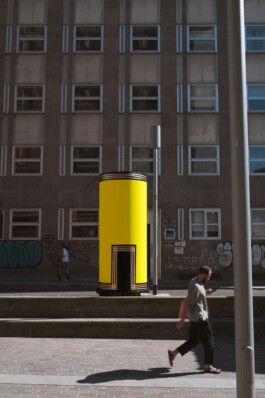
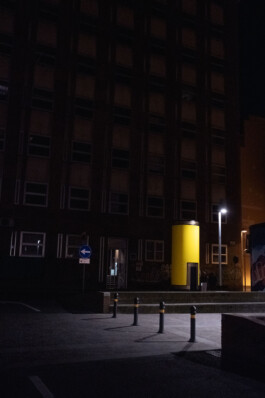

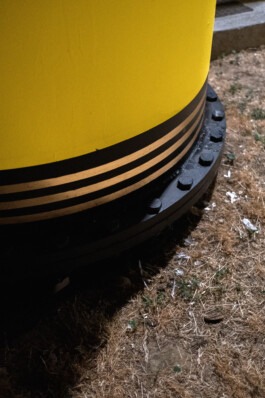
« Art goes through cycles. It is paradoxical, but it happens to me that I get passionate about something and then overcome it, sometimes rejecting it, and at the same time I look at something else, and this other, for some of its aspects, I had rejected in the
past and now I revisit it because I rediscover the validity of some of its qualities and decide to rework it. I think what’s important is trying to understand the why behind this or that behavior of images; nothing happens by chance.
Unfinished building.
Turin, 2023.
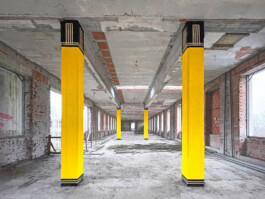
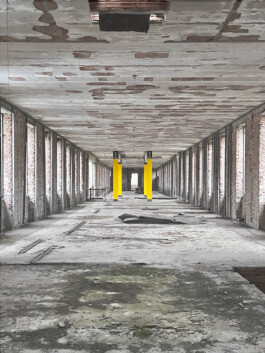
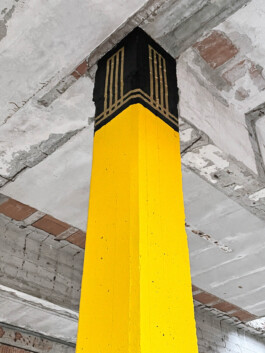
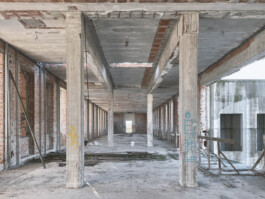
The movements at the origin of contemporary mural art are Mexican muralism and graffiti. The former made political-social commitment its main raison d’être, aiming to create a national identity following the revolution. A few decades later in the USA, writers wanted to denounce the overflowing advertising system and find an identity in a depersonalizing society. To do this, they obsessively demarcated the urban territory, exacerbating with additional images a visual space already saturated.
The work of that Mexican school still reminds us today of the responsibility of the image in constructing a collective imaginary, and writing has shed light on the psycho-physical disturbance generated by advertising. Nevertheless, images continue to be added, with infrequent questioning of their responsibility and our awareness towards them, including mural art.
Air inlets for a pedestrian motorway subway.
Spray and acrylic on concrete.
90 x 220ø cm.
Bologna, 2023.
street view history →
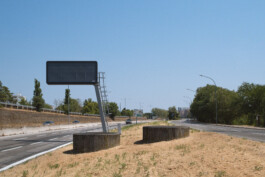
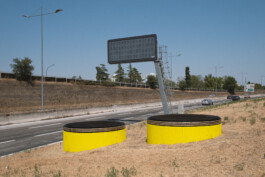
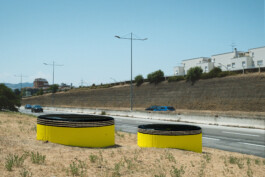
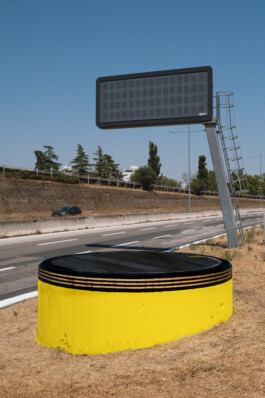
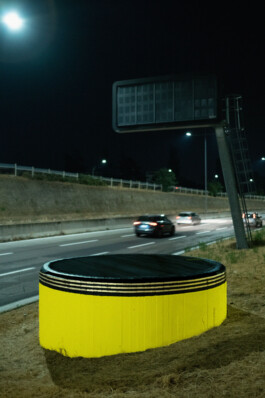
An image is never neutral, and when an artist agrees to work on a large surface occupying a public visual space, they partially adhere to the advertising paradigm itself. Occupying a common visual space to talk about something, inevitably, also means talking about oneself. I include myself among these: Signalogia is not a neutral imaginary, and, if called to intervene on a surface in public space, I wouldn’t refuse in the name of a certain visual hygiene.
Stairwell end.
Marseille, 2023.
google earth→
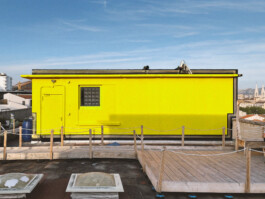
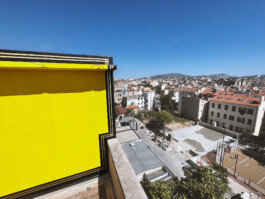
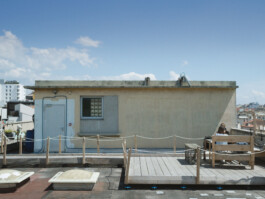
I think the world is beautiful if varied, but precisely, it’s important that it is varied. I believe that a solution, as far as official mural art projects are concerned, is to exploit the rapidity with which these images alternate and to ensure a plurality of subjects, styles, and functions of the image in public space. Meanwhile, the city is out there, within reach, always: an expressive field that it's up to us, inhabitants, to make our horizontal spokesperson.
Electric control cabin.
Acrylic and spray on concrete.
Bologna, 2023.
street view history →
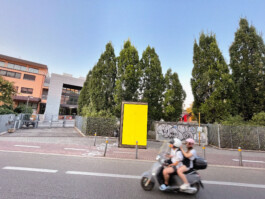
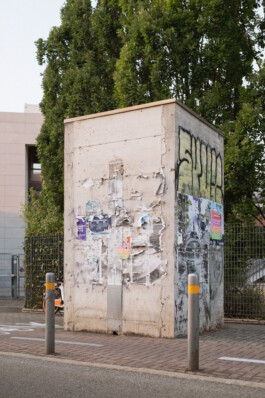
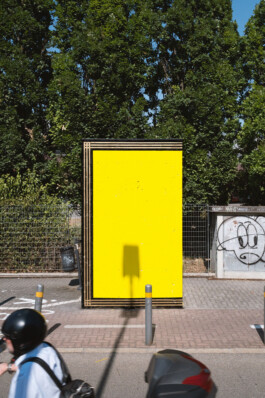
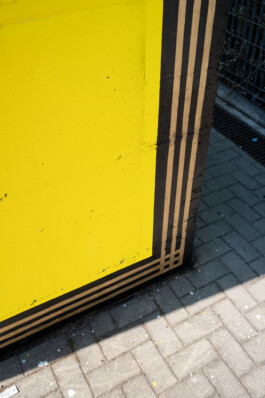
I think that there isn’t a black-and-white solution. I believe it’s a continuous flow of paradoxes, but what’s important is to fuel the awareness towards images. Personally, at this moment, my piece within this large mosaic is to think of a mural art that lightens the weight of urban life, expanding what of the city we perceive as hospitable.
Air inlet for an underground parking lot ventilation.
Spray and acrylic on steel.
Bologna, 2023.
street view history →
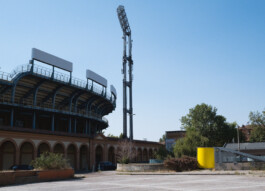
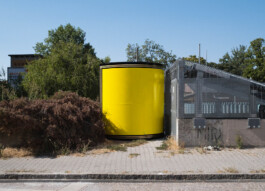

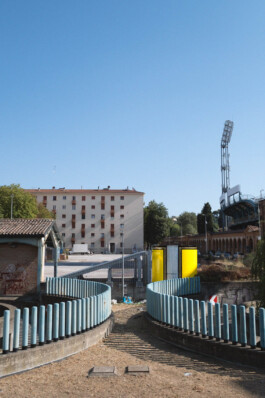
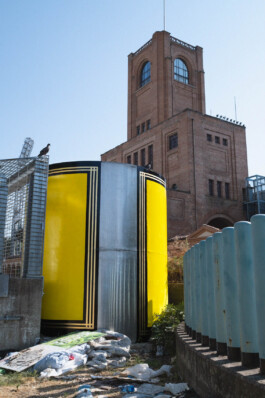
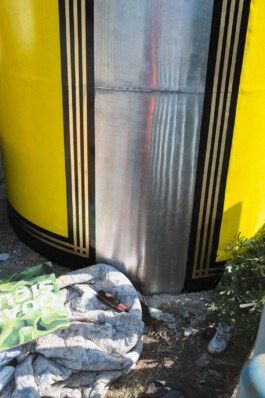
Repeatedly marking the urban landscape is an act that has roots in my background in graffiti. It’s a practice along with which I’ve traversed the aestheticizing process of today’s mural art and that culminates, in Signalogia, in an essentialization of form: it’s the space that suggests the intervention, an architecture-based practice.
Former windmill,
Stromboli, 2023
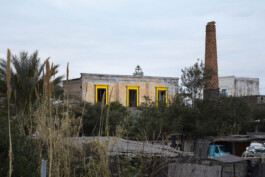
The dividing frame becomes a conjoining seam from the right perspective.
Within its boundaries, the solid color is flat, but potentially deep or reflective depending on our gaze. Yellow is a symbol of joy, in it just as in the sky, we can lose our gaze and travel towards a broader imaginary, from within the city to beyond the border.»
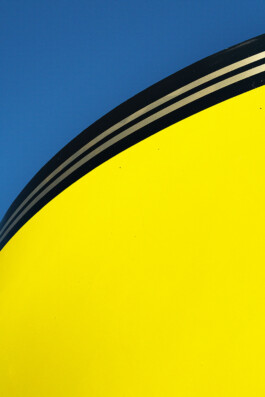
Former fiberglass silo for maltitol syrup production.
Acrylic and spray on fiber glass and concrete.
520 x 220ø cm.
Bologna, 2023.
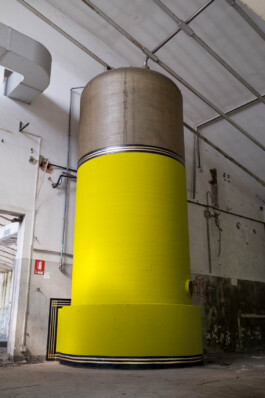
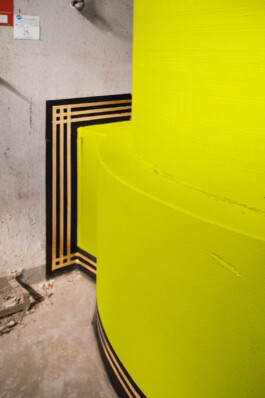
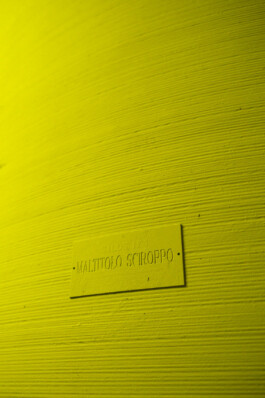
Former train assembly plant,
variable dimensions,
Turin, 2023.
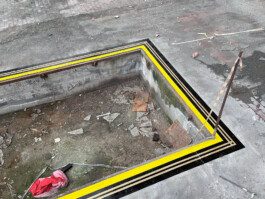
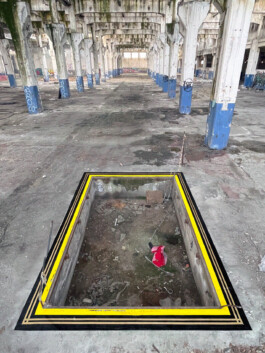
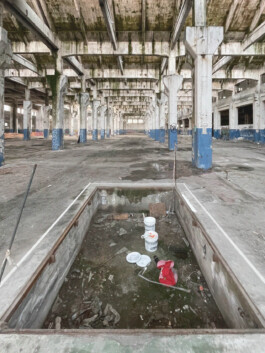

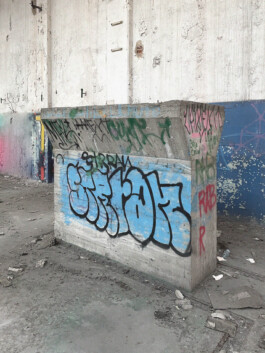

Signalogia
Through a painting-photography-video pratice Signalogia infuses identity into anonymous spaces calling upon the inhabitants to re-identify themselves within the urban context. As the city margin expands, so does the prevalence of anonymous spaces. Signalogia proposes an inward expansion, highlighting new potentials within the already existing border of the metropolis.
By bringing presence to otherwise invisible actors like air-inlets, silos, electrical junctions, they are made accomplices in the alternative city.
(2022-on going, Italy, France, Mexico)




Project genesis:
In November 2019, the Metzicans, a trio of Mexican artists friends, invited me to visit them to paint in their city, Toluca. In two days, I painted this. However, on the evening of the first day, I decided to take a photo of the work’s progress. For some reason, I liked that «intermediate» state of completion; in its being «less» graphically, I found more expressive potential. I considered leaving it as it was; it felt finished to me, but I wasn’t sure. In the context of Mexican mural art, it appeared as something unfinished, the background for an upcoming image. Discussing it with my friends, we agreed it was better to create something more enriching; the next day, I «finished» it. The photo I took of the work-in-progress was piece.





By coincidence, that was the last mural I completed before embarking on a two-year cycle around the Intemperias project, a painting practice mainly developed in the studio.
By the end of 2021, I felt the need to return to painting in public spaces and accepted the invitation from some artist friends in Turin to paint in various locations around the city. I wanted to explore that intuition I had in Mexico: to work more in situ, distance myself from the concept of an image merely to be observed, and try something that would function as a presence in space. These and other thoughts were going through my mind.



« Art goes through cycles. It is paradoxical, but it happens to me that I get passionate about something and then overcome it, sometimes rejecting it, and at the same time I look at something else, and this other, for some of its aspects, I had rejected in the past and now I revisit it because I rediscover the validity of some of its qualities and decide to rework it. I think what’s important is trying to understand the why behind this or that behavior of images; nothing happens by chance.




The movements at the origin of contemporary mural art are Mexican muralism and graffiti. The former made political-social commitment its main raison d’être, aiming to create a national identity following the revolution. A few decades later in the USA, writers wanted to denounce the overflowing advertising system and find an identity in a depersonalizing society. To do this, they obsessively demarcated the urban territory, exacerbating with additional images a visual space already saturated.
The work of that Mexican school still reminds us today of the responsibility of the image in constructing a collective imaginary, and writing has shed light on the psycho-physical disturbance generated by advertising. Nevertheless, images continue to be added, with infrequent questioning of their responsibility and our awareness towards them, including mural art.






An image is never neutral, and when an artist agrees to work on a large surface occupying a public visual space, they partially adhere to the advertising paradigm itself. Occupying a common visual space to talk about something, inevitably, also means talking about oneself. I include myself among these: Signalogia is not a neutral imaginary, and, if called to intervene on a surface in public space, I wouldn’t refuse in the name of a certain visual hygiene.

I think the world is beautiful if varied, but precisely, it’s important that it is varied. I believe that a solution, as far as official mural art projects are concerned, is to exploit the rapidity with which these images alternate and to ensure a plurality of subjects, styles, and functions of the image in public space. Meanwhile, the city is out there, within reach, always: an expressive playground that it's up to us, inhabitants, to make our horizontal spokesperson.



Repeatedly marking the urban landscape is an act that has roots in my background in graffiti. It’s a practice along with which I’ve traversed the aestheticizing process of today’s mural art and that culminates, in Signalogia, in an essentialization of form: it’s the space that suggests the intervention, an architecture-based practice.




The dividing frame becomes a conjoining seam from the right perspective.
Within its boundaries, the solid color is flat, but potentially deep or reflective depending on our gaze. Yellow is a symbol of joy, in it just as in the sky, we can lose our gaze and travel towards a broader imaginary, from within the city to beyond the border. »






